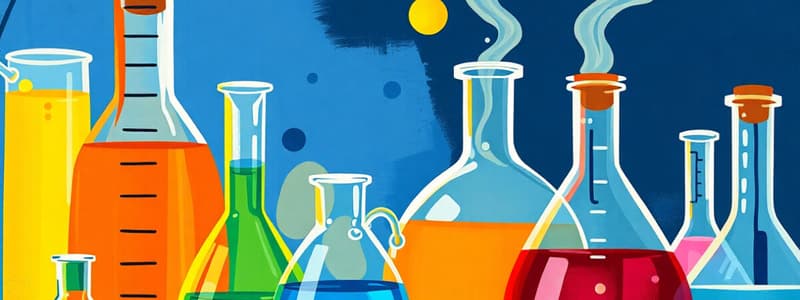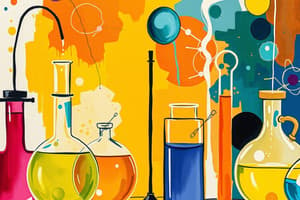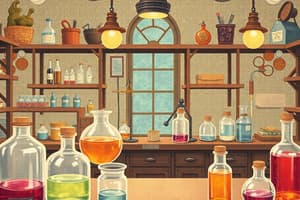Podcast
Questions and Answers
What is used to hold liquids and has a narrow neck to prevent splashes?
What is used to hold liquids and has a narrow neck to prevent splashes?
- Graduated cylinder
- Beaker
- Petri dish
- Erlenmeyer flask (correct)
What is the chemical symbol for Potassium?
What is the chemical symbol for Potassium?
K
What is the chemical symbol for Chromium?
What is the chemical symbol for Chromium?
Cr
What is the chemical symbol for Sulfur?
What is the chemical symbol for Sulfur?
What is the chemical symbol for Phosphorus?
What is the chemical symbol for Phosphorus?
What is the chemical symbol for Carbon?
What is the chemical symbol for Carbon?
What is the chemical symbol for Manganese?
What is the chemical symbol for Manganese?
What is the chemical symbol for Iodine?
What is the chemical symbol for Iodine?
What is the chemical symbol for Nitrogen?
What is the chemical symbol for Nitrogen?
What is the definition of an atom?
What is the definition of an atom?
What is the definition of an element?
What is the definition of an element?
A chemical combination of two or more elements/atoms is called what?
A chemical combination of two or more elements/atoms is called what?
Which of the following are examples of compounds? (Select all that apply)
Which of the following are examples of compounds? (Select all that apply)
Hydrogen (H) is an element and cannot be broken down by ordinary means.
Hydrogen (H) is an element and cannot be broken down by ordinary means.
Table Salt is an element and cannot be broken down by ordinary means.
Table Salt is an element and cannot be broken down by ordinary means.
Carbon Dioxide (CO2) is an element and cannot be broken down by ordinary means.
Carbon Dioxide (CO2) is an element and cannot be broken down by ordinary means.
Glucose (C6H12O6) is an element and cannot be broken down by ordinary means.
Glucose (C6H12O6) is an element and cannot be broken down by ordinary means.
Helium (He) is an element and cannot be broken down by ordinary means.
Helium (He) is an element and cannot be broken down by ordinary means.
Water (H2O) is an element and cannot be broken down by ordinary means.
Water (H2O) is an element and cannot be broken down by ordinary means.
What are always at the beginning of a chemical reaction, and what are always at the end?
What are always at the beginning of a chemical reaction, and what are always at the end?
What can be used to speed up a reaction that is too slow?
What can be used to speed up a reaction that is too slow?
What is digestion an example of?
What is digestion an example of?
What pH range do acids have?
What pH range do acids have?
When added to an aqueous solution, what do acids produce?
When added to an aqueous solution, what do acids produce?
What is the approximate pH of a strong acid?
What is the approximate pH of a strong acid?
What is the pH of a neutral substance?
What is the pH of a neutral substance?
A strong base can cause as much damage to a living thing as a strong acid.
A strong base can cause as much damage to a living thing as a strong acid.
What are responsible for preventing changes in pH?
What are responsible for preventing changes in pH?
What do buffers help to maintain?
What do buffers help to maintain?
What does DNA stand for?
What does DNA stand for?
What kind of reproduction requires the fusion of a sperm and egg that combine their genetic material to produce a new organism?
What kind of reproduction requires the fusion of a sperm and egg that combine their genetic material to produce a new organism?
What kind of reproduction involves only one parent and produces offspring that are identical to the parent?
What kind of reproduction involves only one parent and produces offspring that are identical to the parent?
What kind of organism can produce its own food for energy?
What kind of organism can produce its own food for energy?
What kind of organism must consume food for energy and cannot make their own food?
What kind of organism must consume food for energy and cannot make their own food?
What is biology the study of?
What is biology the study of?
What is called the process by which as the cells in a multicellular organism multiply, they become different from each other?
What is called the process by which as the cells in a multicellular organism multiply, they become different from each other?
What refers to the stable level of internal conditions in organisms?
What refers to the stable level of internal conditions in organisms?
How are cells and groups of cells organized in most multicellular organisms?
How are cells and groups of cells organized in most multicellular organisms?
The sum of all the chemical processes that occur in an organism is called what?
The sum of all the chemical processes that occur in an organism is called what?
How do non-living things grow?
How do non-living things grow?
What is called the process by which an organism becomes its mature form?
What is called the process by which an organism becomes its mature form?
List the six characteristics of living things
List the six characteristics of living things
Why do organisms require energy?
Why do organisms require energy?
What is the difference between growth and development in a multicellular organism?
What is the difference between growth and development in a multicellular organism?
Is reproduction essential to the survival of an individual organism?
Is reproduction essential to the survival of an individual organism?
Why is the cell the basic unit of life?
Why is the cell the basic unit of life?
Give a specific example of an organism maintaining homeostasis
Give a specific example of an organism maintaining homeostasis
Contrast the reproduction of bacteria with that of humans
Contrast the reproduction of bacteria with that of humans
What is the difference between a unicellular and a multicellular organism?
What is the difference between a unicellular and a multicellular organism?
What word is used to describe the stable internal conditions of a living thing?
What word is used to describe the stable internal conditions of a living thing?
Give one specific example of an organism maintaining homeostasis. Be sure to include the who, the what, and the why
Give one specific example of an organism maintaining homeostasis. Be sure to include the who, the what, and the why
Finish this sentence. All living things... (include all 6 answers and know the details)
Finish this sentence. All living things... (include all 6 answers and know the details)
What is the difference between an observation, a hypothesis and an inference? Be able to distinguish between observations, hypotheses and inferences.
What is the difference between an observation, a hypothesis and an inference? Be able to distinguish between observations, hypotheses and inferences.
What is the difference between qualitative and quantitative data?
What is the difference between qualitative and quantitative data?
What is a control group? Be able to identify the control group in an experimental set-up.
What is a control group? Be able to identify the control group in an experimental set-up.
What is the difference between an independent and a dependent variable? Be able to identify independent and dependent variables in an experimental set-up.
What is the difference between an independent and a dependent variable? Be able to identify independent and dependent variables in an experimental set-up.
What is the difference between an element and a compound?
What is the difference between an element and a compound?
Define an Atom
Define an Atom
What is activation energy? How is activation energy represented on a reaction graph?
What is activation energy? How is activation energy represented on a reaction graph?
What is a catalyst?
What is a catalyst?
What is an enzyme?
What is an enzyme?
Why are enzymes important to living things?
Why are enzymes important to living things?
How does the presence of an enzyme or catalyst affect a reaction graph?
How does the presence of an enzyme or catalyst affect a reaction graph?
Label the reactants and the products in the reaction below.
CO2 + H20 🡪 H2CO3
Label the reactants and the products in the reaction below. CO2 + H20 🡪 H2CO3
What is a solution? What are the two parts of every solution?
What is a solution? What are the two parts of every solution?
What is a hydroxide ion?
What is a hydroxide ion?
Define acid
Define acid
What is a buffer?
What is a buffer?
What is a neutral pH? What does this mean?
What is a neutral pH? What does this mean?
What is the pH of an acid?
What is the pH of an acid?
Flashcards
Scalpel
Scalpel
a surgical knife used for making precise incisions in biological specimens.
Petri Dish
Petri Dish
a shallow, circular, transparent dish with a flat lid, used for the culture of microorganisms.
Test Tube
Test Tube
A thin glass tube closed at one end, used to hold small amounts of material for laboratory testing or experiments.
Test Tube Rack
Test Tube Rack
Signup and view all the flashcards
Test Tube Holder
Test Tube Holder
Signup and view all the flashcards
Beaker
Beaker
Signup and view all the flashcards
Graduated Cylinder
Graduated Cylinder
Signup and view all the flashcards
Microscope Slide
Microscope Slide
Signup and view all the flashcards
Cover Slip
Cover Slip
Signup and view all the flashcards
Funnel
Funnel
Signup and view all the flashcards
Forceps
Forceps
Signup and view all the flashcards
Test Tube Brush
Test Tube Brush
Signup and view all the flashcards
Potassium
Potassium
Signup and view all the flashcards
Chromium
Chromium
Signup and view all the flashcards
Sulfur
Sulfur
Signup and view all the flashcards
Phosphorus
Phosphorus
Signup and view all the flashcards
Carbon
Carbon
Signup and view all the flashcards
Calcium
Calcium
Signup and view all the flashcards
Manganese
Manganese
Signup and view all the flashcards
Iron
Iron
Signup and view all the flashcards
Magnesium
Magnesium
Signup and view all the flashcards
Iodine
Iodine
Signup and view all the flashcards
Fluorine
Fluorine
Signup and view all the flashcards
Zinc
Zinc
Signup and view all the flashcards
Oxygen
Oxygen
Signup and view all the flashcards
Copper
Copper
Signup and view all the flashcards
Chlorine
Chlorine
Signup and view all the flashcards
Nitrogen
Nitrogen
Signup and view all the flashcards
Hydrogen
Hydrogen
Signup and view all the flashcards
Study Notes
Laboratory Equipment
- Erlenmeyer flask: Holds liquids, narrow neck prevents splashes.
- Scalpel: Surgical knife.
- Petri dish: Circular, shallow dish for culturing microorganisms.
- Test tube: Thin glass tube for holding small samples.
- Test tube rack: Holds test tubes.
- Test tube holder: Spring metal for holding test tubes or tubing.
- Beaker: Open cylindrical container with pouring lip, used for mixing larger amounts.
- Graduated cylinder: Measures liquid volume.
- Microscope slide with cover slip: Holds specimens for microscope examination.
- Funnel: For pouring liquids through small openings.
- Forceps: For holding small items.
- Test tube brush: For cleaning test tubes.
Chemical Elements (Symbols)
- Potassium (K)
- Chromium (Cr)
- Sulfur (S)
- Phosphorus (P)
- Carbon (C)
- Calcium (Ca)
- Manganese (Mn)
- Iron (Fe)
- Magnesium (Mg)
- Iodine (I)
- Fluorine (F)
- Zinc (Zn)
- Oxygen (O)
- Copper (Cu)
- Chlorine (Cl)
- Nitrogen (N)
- Hydrogen (H)
- Cobalt (Co)
Basic Chemistry Concepts
-
Atom: Smallest particle of an element retaining its properties.
-
Element: Substance not broken down by ordinary means.
-
Compound: Chemical combination of two or more elements.
-
Examples of compounds: CO, NaCl, H2O, CO2, C6H12O6, H2O
-
Hydrogen (H): An element that cannot be broken down.
-
Table Salt (NaCl): A compound that can be broken down
-
Carbon Dioxide(CO2): A compound that can be broken down.
-
Glucose(C6H12O6): A compound that can be broken down.
-
Helium (He): An element that cannot be broken down.
-
Reactants & Products: Reactants before arrow, products after. Chemical reactions and catalysts:
-
Reactions can be sped up with catalysts.
-
Digestion is an example of reaction, requiring enzymes.
Acids and Bases
- Acids (pH): Below 7
- Acids produce hydronium ions (H+) in solution
- Strong acids pH: 0
- Bases (pH): Above 7
- Bases produce hydroxide ions (OH-) in solution.
- Strong bases pH: Close to 14
- Neutral substances (pH): 7
- Strong bases can cause damage similar to strong acids.
- Buffers: Maintain homeostasis by neutralizing acids and bases.
- Buffers maintain homeostasis by keeping internal pH stable.
Biology Concepts
- DNA: Deoxyribonucleic acid, carries genetic information.
- Sexual Reproduction: Fusion of sperm and egg. Offspring differ from parents.
- Asexual Reproduction: Reproduction from one parent. Offspring identical to parent.
- Autotroph: Produces its own food.
- Heterotroph: Consumes food for energy.
- Biology: Study of all living things.
- Differentiation: Cells becoming different in multicellular organisms.
- Homeostasis: Stable internal conditions in organisms.
- Organization of cells in multicellular organisms: By function.
- Metabolism: Sum of chemical processes in an organism.
- Growth in non-living things: Accumulation of material.
- Development: Process of becoming mature.
- Characteristics of living things: Cells, energy use, homeostasis, organization, reproduction, growth & development.
- Energy needs: Function, homeostasis, growth, development, reproduction.
- Growth vs. Development: Growth: enlargement, cell division; Development: cell differentiation.
- Reproduction necessity: Essential for survival and diversity of the species.
- Importance of cells: Smallest unit with life’s characteristics.
- Homeostasis example: Shivering (muscles to generate heat)
- Comparison unicellular/multicellular: Unicellular is one cell, multicellular multiple cells with specific functions.
- Stable internal conditions: Homeostasis.
- Homeostasis example: Sweating (body temperature regulation).
Scientific Method
-
Observation: Information through senses.
-
Hypothesis: Testable prediction.
-
Inference: Conclusion based on observation.
-
Qualitative data: Descriptive.
-
Quantitative data: Numerical.
-
Control group: Group not receiving treatment.
-
Independent variable: Factor manipulated.
-
Dependent variable: Factor measured.
-
Element vs. compound: Element: pure substance; compound: combination of elements.
-
Activation energy: Minimum energy for a reaction.
-
Catalyst/Enzyme: Speeds up reactions without changing itself.
-
Enzyme importance: Crucial for life processes. (digestion, respiration, etc.).
-
Enzyme effect on reaction graph: Lowers activation energy.
-
Reactants & products in CO2+H2O -> H2CO3: CO2 and H2O are reactants, H2CO3 is product
-
Solution: Substance where one material dissolves completely in another Solvent and Solute: Parts of a solution
-
Hydroxide ion: (OH⁻)
-
Hydronium ion: (H₃O⁺)
-
Acid: Increases H+ ion concentration.
-
Base: Produces OH- ions in solution.
-
Buffer: Minimizes pH changes.
-
Neutral pH: 7; Balanced H+ and OH-.
-
Acid pH: Less than 7.
-
Base pH: Greater than 7.
Studying That Suits You
Use AI to generate personalized quizzes and flashcards to suit your learning preferences.



